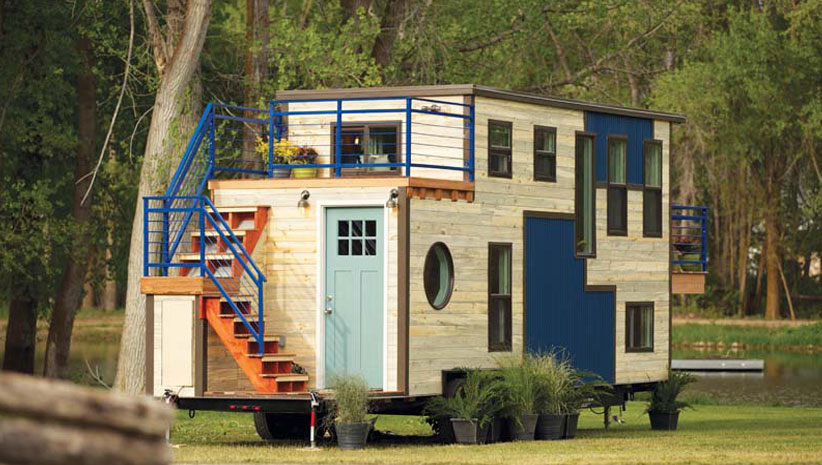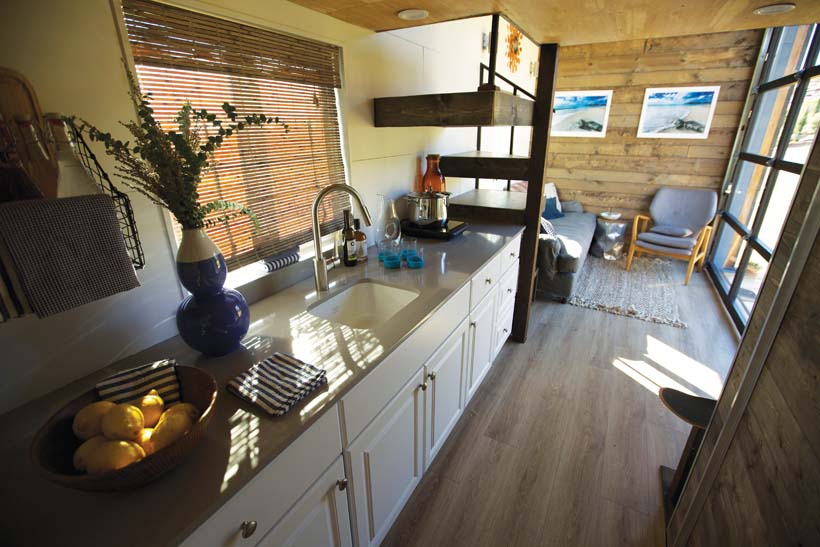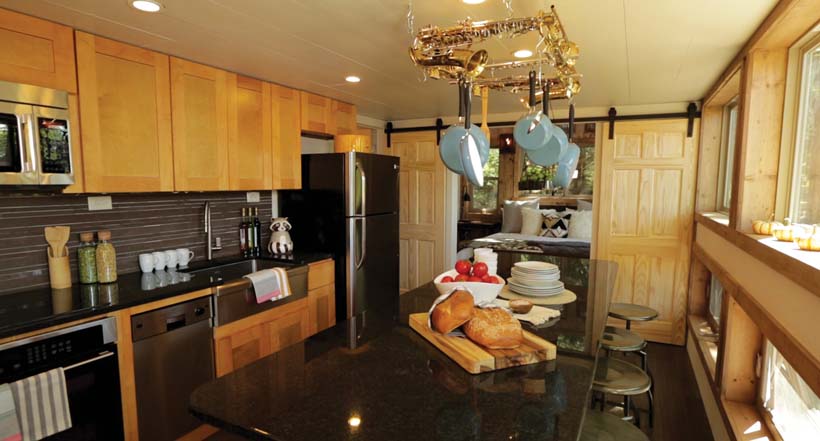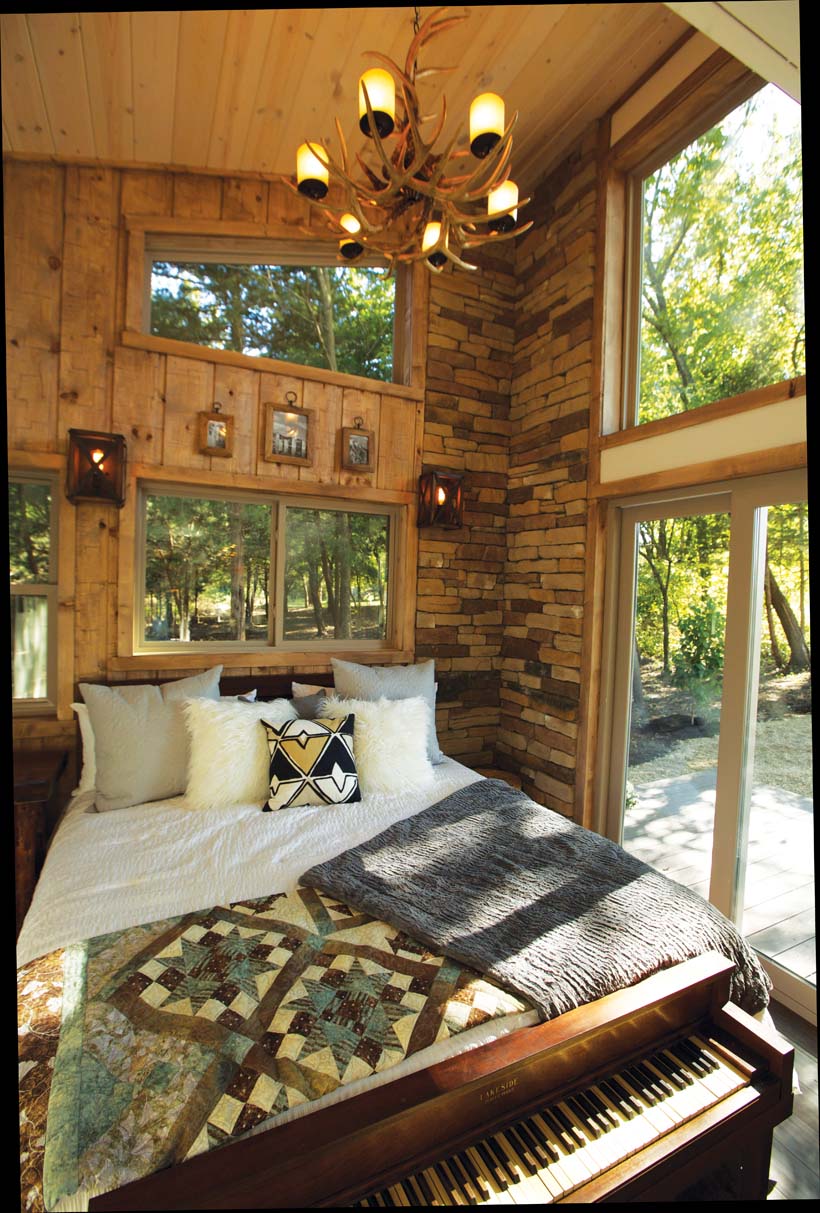
A thoughtful Approach to Tiny Houses
If you’ve ever dreamed of downsizing, choosing what is most essential, or living a more mobile lifestyle; if you’ve imagined yourself as a minimalist, or looked for ideas to increase the efficiency or creativity of your space, you may be following the tiny house movement. The categorization of a tiny home varies a bit based on what source you consult, but basically, a tiny home is usually described as smaller than 400 square feet (500 on Tiny House Nation). The definition also depends on how many people are living in the space—or what you are downsizing from. In any case, the creativity and artistry of these homes offers inspiration that we can all learn from, whatever our personal dwelling.
The movement is gaining momentum to the point that there are a number of TV shows related to the themes of designing, building, or living in tiny houses. On Tiny House Nation on FYI (part of the A+E Networks) people build creative tiny houses that add power and performance to their lives. Show host John Weisbarth’s affable and relatable nature is complemented by co-host and contractor Zack Giffin’s creative building and problem-solving techniques.
It doesn’t take long when speaking with Zack to realize that he’s more than a builder with cool suspenders and a person whose dream of pursuing life as a professional skier led to his own build of a tiny house. Zack maintains a thoughtful perspective on the power and politics of the tool of a tiny home in the toolbox of modern living and how this movement relates to yoga. We spoke to him just before he gave a talk on Freedom at TEDxCoral Gables and then shared the stage with Tony Robbins in Toronto.

Themes Connecting Yoga and the Tiny House Movement
LA YOGA: Some of the themes we love around the tiny house movement relate to identifying essentials that you need in your life and how to set up your home for best performance. We appreciate the creative solutions that you bring to building a house and the scenarios that relate to performance, functionality, and efficiency.
Zack Giffin: I see a lot of parallels with the tiny house movement and yoga. Your body is a tool, right? And honing that tool, sharpening the tool creates a better experience in this world.
I like to look at a house as a tool to facilitate your life. I like to talk about breaking down the function of the home in terms of efficiency. With tiny homes, efficiency is the name of the game.
Another concept I get inspired by is the idea of the power of the home. To me the power of a home comes down to someone’s appreciation of the space as well as the ability for the space to facilitate a person or family’s quality of life.
This is similar to yoga practice. You’re talking about honing your tool, your body, to facilitate your enjoyment of this experience in this world. The home, in my mind, is much the same. When I talk about power it really comes down to—whether it’s a big space or a small space—finding those custom elements that makes someone feel like that space is theirs and creates an environment that someone can appreciate. That’s what I think is important in design.
I find it inspiring when a home is both powerful and a tool to open opportunity and facilitate growth in someone’s life. Many people are looking at the tiny home movement as a way to side-step a lot of the financial traps that leave people just treading water. So many people have dreams that feel unattainable, or work in jobs that they’re not totally passionate about, or feel for whatever reason they don’t have enough time for themselves, their family, or the things that make life worth living.
That’s what I really love about the tiny house movement. Having your house assist you in being able to take back this hold over your time and spend it doing things that make you feel like you’re directly in line with how you want to live your life.
As an example, I built a home for a young man and his wife. His dream was to be a pilot and he had this clunky flight simulator that just seems like the type of thing that has no place in a tiny home. If I could find a way to incorporate this in a way that doesn’t detract from the home, then this item has the ability to help him follow his dream.
If I create a writing nook for someone whose passion is to be a writer but they can’t seem to find the time—but then that writing nook inspires them to carve out the time and it enables them to finalize that novel and then turns into a scenario where they become a published author—that is another example. That sense of gratification and satisfaction will be with you for the rest of your life. That’s what I think about when I’m designing homes.
There’s a similar opportunity with creating space for yoga practice. A lot of people are fans of yoga but can’t always find the time. If you can build a space within a home that incentivizes someone to practice and that is what tips the scales to them making it a part of their life, then they get to enjoy all of the benefits from yoga—that’s another example of how a home can facilitate growth in somebody’s life.

Applying Lessons Learned to Designing Tiny Homes
LA YOGA: In any type of home, we look for ways to life effectively and harmoniously in our everyday lives, which is the case at Precondo. In the Tiny House Movement, what are some things you’ve learned working with all these people to set up tiny homes, that people can apply to their everyday lives whether or not they are in a tiny home?
ZG: I see a lot of commonalities when people start trying to move into very small spaces. People have to look at what they need and what they can live without. Yet, one of the very first things to go is the dining room table. To me that’s a shame, because when we’re talking about quality of life, the experience of sitting down and having engagement across from another person at a dining room table is something that we shouldn’t take away from ourselves.
When designing, I look at ways to transform a space so that you can get multiple uses out of it. In addition, I look for elements that are being left out. If someone doesn’t have a laundry option, I ask some of the following questions. “How is your life going to work without the ability to do laundry? Are you planning on going to a laundromat? Is that something that’s built in or are you just neglecting to prioritize it?”
After that I try to learn as much as I can about the person’s specific needs. There’s a couple in Sacramento, Melissa and Justin, who run a nonprofit where they get kids from urban settings out into nature. They’re always needing to create lunches for all these kids. What it came down to was they just needed a lot of prep space. They needed a counter space on a level that most tiny houses don’t actually incorporate. So we had a real fun time building these chunks of counter top that were tucked away that folded out and opened out to give them a lot of flat space that they could use to make sandwiches. I called it, “The industrial sandwich station.” John [Zack’s Tiny House Nation co-host] thinks it’s hilarious that I like to call everything “industrial,” I don’t know why I do it; I guess it sounds good!

Creating Greater Efficiency at Home
LA YOGA: What are some other examples related to efficiency?
ZG: We incorporate a lot of vertical storage; “vertical storage” is a big catch phrase you’ll hear a lot. That relates to efficiency and the mentality of tiny houses where everything has its place. If you’re willing to have an item to the point where you know that it has to have its own space, then it makes you think about whether or not you actually need that item. If you know where everything goes it’s like a well-organized wood shop—you know for example that your T-square goes over here so that every time you need it you go right for it.
The downside of vertical space is that it takes away from wall space—if you like surrounding yourself with artwork, or windows. We talk a lot about having big windows in small spaces to let the light in and it feels bigger, but as soon as you put a window there goes your opportunity to use that space for storage, so it’s a balance of priorities. Personally, I prioritize windows.
Appreciating Space in Tiny Houses
LA YOGA: That sounds like it relates to one of the concepts you began with, of appreciating the space.
ZG: Yes, and if it feels more open, you can feel as though you have some access to the outdoors. But then again, the decision can also come down to, “Do you have something outside your window that’s worth looking at or are you just looking at a straight brick wall?” Then maybe you’d rather have storage. It’s also all right to understand that your needs for space will fluctuate at different times in your life.
When we start to consider some of the larger factors of the needs in your life, it’s hard for me to talk to people about tiny houses without talking about the fact that I see tiny houses as a response to a growing set of environmental and economic factors in the world today. Once you start talking about those factors, the conversation takes so long because they’re really big elements and there are no perfect or easy solutions. But for a lot of us, tiny houses are a tool to live a life that we choose. They are a tool to avoid some of the economic traps that leave so many people treading water.

Advocating for Freedom
LA YOGA: Do you mean the economic trap of over-extending to buy a bigger house than you need?
ZG: Right, that limits our freedom in terms of mobility. That forces us into jobs that we don’t really love because we’re just trying to pay the mortgage. When I bought my motor home, it was about putting my foot down and saying, “You know what? The expenses in my life are forcing me to work 9-5 and I have this passion for skiing and I want to pursue this dream, and if it’s going to be a reality then I have to find a way to focus more time on it.” So it was this tool that I used, before tiny houses were invented, or the term was ever coined, to follow this dream. I think the reason I am an advocate for the movement is because it worked for me.
My responsibility as an advocate for the movement and one of the more visible people in it, is to not only realign people’s notions about what a tiny house is, because I don’t feel that it is just an infatuation with all things small and cute—I think it is people looking at tiny houses as a tool to regain their freedom. Many people today feel like we don’t have any power as individuals. That leads to apathy. The tiny house movement is a direct contradiction to that conclusion.

Zoning, Legal Issues, and Tiny Houses
The biggest problem with tiny houses right now is not, “How do you pare down your shoe collection so you can fit your life into one;” the biggest problem we have is laws that make it almost impossible to live in one legally.
As an ambassador to the movement I take it seriously to articulate how the tiny house can not only be a tool for individuals to regain control of their own lives, but it can be a tool for our country to address some of the needs for improved efficiency and empowered communities. That is where I think tiny houses have an amazing opportunity. Because of the sheer fact that they’re small they can fit into the cracks within our existing infrastructure, and we can implement housing that is disbursed throughout communities.
For example, there are places in our country that have set some amazing precedents. Fresno has re-written their zoning policy to allow tiny houses on wheels to be used as accessory dwelling units on existing properties on lots of at least 6,000 square feet (5,000 square feet for corner lots). In essence, it allows the property owner who could use the relief of having a rental space the ability to partner with a family who might not be able to afford to live in that community but can afford a tiny house in partnership. I love this because I love the concept of community and people partnering to solve problems. Ojai, California, is about to adopt the same zoning policy as Fresno, and it’s actually on the books in Los Angeles as well.
I’m hopeful that as we get closer to what I’m seeing as an unavoidable downturn in our housing, there will be ways for more municipalities to open up their zoning restrictions to tiny houses so it can be a multi-purpose solution.
I think the reality of the world is shifting. Families are smaller and are moving around a lot more than they used to, so the idea of owning a home on wheels could be a real advantage. The American dream of the white picket fence is getting rearranged a bit to incorporate this desire for experience over material possessions.
More people are moving into city centers, we have massive traffic problems, we have a climate that is in crisis, and we have an economy that is based upon using our real estate as an investment to the point that it is becoming out of reach to large segments of the population.
When we’re talking about the homeless problem, for example, the veterans’ supporters like to say, “Oh, the government is not supporting veterans.” It’s not necessarily about that as much as it is that veterans happen to be members of our society and we’re getting to this point where housing is unattainable to more and more of us. I see that this system is flawed and I just have the feeling that we can do better.
My work in building tiny homes has put me in a place where I’m constantly looking for solutions that solve two problems at once. If you can relieve stress for people who feel like they’re just treading water and at the same time provide a better method of affordable housing—that’s the win/win solution of multipurpose design. To me, that’s the hallmark of a powerful design.
Tiny houses are a tool. The needs of this world have shifted although our laws haven’t quite kept up. We need to start looking at all the tools available to us to address the needs of a changing world.

Transformation Beyond Tiny Houses
LA YOGA: Your commitment to the Tiny House Movement has a very big picture perspective.
ZG: Yes it does. That’s why I find it hard to talk to people about tiny houses just on the level of, “Oh it’s so cute and it’s so cool that they can do all this transformative stuff.” Because I’m drawing broader conclusions about what it’s all about.
LA YOGA No matter what kind of home you’re living in, you can incorporate these transformative lessons in every part of your life.
ZG: It might sound cliche, but it comes down to this awareness that there are necessities for happiness. We do need security, shelter, warmth, and food in our belly, but after you have those fundamental needs fulfilled, the actual things that make life beautiful have nothing to do with wealth. They’re all about the love and the time we get to have with each other, the way that we’re treated by the people in our community, and the ability to have positive self-esteem. These intangibles make up the beauty of this life.
I think more and more people are starting to not just understand that but actually take real physical action to make sure they prioritize that stuff with their life. That is what I believe is the common denominator of this entire movement, and it’s probably why I feel like there’s relevance to the tiny home movement within the world of yoga.
Tiny House Nation and Zack Giffin
All Photos Courtesy of FYI / Tiny House Nation.
Tiny House Nation premieres on the FYI network on Saturdays at 9pm ET. For more information, visit the show’s website: fyi.tv/shows/tiny-house-nation
For more information on Zack Giffin, his skiing life, his speaking schedule, and photos of his tiny house, visit: zackgiffin.com
Felicia Tomasko has spent more of her life practicing Yoga and Ayurveda than not. She first became introduced to the teachings through the writings of the Transcendentalists, through meditation, and using asana to cross-train for her practice of cross-country running. Between beginning her commitment to Yoga and Ayurveda and today, she earned degrees in environmental biology and anthropology and nursing, and certifications in the practice and teaching of yoga, yoga therapy, and Ayurveda while working in fields including cognitive neuroscience and plant biochemistry. Her commitment to writing is at least as long as her commitment to yoga. Working on everything related to the written word from newspapers to magazines to websites to books, Felicia has been writing and editing professionally since college. In order to feel like a teenager again, Felicia has pulled out her running shoes for regular interval sessions throughout Southern California. Since the very first issue of LA YOGA, Felicia has been part of the team and the growth and development of the Bliss Network.
